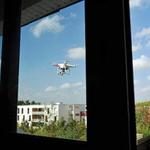By Avery Conner
In 2011, drone history was in the making. Commonly known and debated almost entirely for military use overseas, there was a switch in focus to homeland security in June when a Predator drone was used to help police arrest civilians in North Dakota in what “was hailed at the time as the first drone-assisted arrest on American soil.” The situation seemed straight out of a history book. There was a dispute over cattle ownership and law enforcement officials were met with firearms when, with warrant in hand, they tried to return the cattle to the rightful owner. Straight out of a history book, that is, until the sheriff asked for a drone to be sent in. Used only for surveillance, the Predator drone gave the local law enforcement and SWAT team on site an indication of where the suspects were located, and if they were armed. Perhaps a bit excessive for the circumstances, the results were undeniable: arrests were made, no fatalities or casualties occurred, and a debate was spurred forward.
This and other, similar incidents, raise important questions. Should law enforcement be allowed to use drones, and if so, under what circumstances? Though drones can be vluable for law enforcement, in response to changing technology and a growing fear for privacy in the public, rules and regulations are needed to protect privacy rights and ensure people feel safe with drones being used in law enforcement.
Personal protection against government has been an issue in the United States of America since the country has been in existence, and drones are the next issue to join the list of privacy concerns in the American public. Police have, in the name of public safety, tried to find many ways to gather evidence that tread the boundary of invading personal privacy. Helicopters, pole-mounted cameras, or even just finding a higher vantage point are all techniques used to gather information that are legal in most situations without warrants. Using drones for surveillance seems to fit into the same category as these examples, yet drones truly are a special case. They are often the tools that contain the newest and most sophisticated technology available to law enforcement, including “some of the most powerful multi-spectral sensors [that] can read footprints in a field long after the person who made them has fled.” According to Scott Bomboy in his post “A legal victory for drones warrants a Fourth Amendment discussion,” drones also have the ability to “theoretically listen” while taking surveillance, “use facial recognition technology,” and can even “track every vehicle and person in [an] area, albeit at a low resolution.” As such, they need to have more restrictions to protect privacy. It is not the drone itself that is the problem, it is the technology it has the capability to carry.
As technology advances, regulations are required to match those advancements, lest privacy be completely dismissed as humanity proceeds into the digital age. The American Civil Liberties Union offers suggestions of regulations to put in place, including a drone being “deployed by law enforcement only with a warrant, in an emergency, or when there are specific and articulable grounds to believe that the drone will collect evidence relating to a specific criminal act.” Indeed, this seems to be a commonly proposed rule for drones, as many states are considering requiring warrants for their use. Some, such as North Dakota, already require them.
Data collection is another issue, as drones (equipped with modern technology) have the capability to collect and store tremendous amounts of data on innocent civilians while collecting evidence. Again, rules and regulations have been proposed and, in some cases, put into action. In Grand Forks, North Dakota, for example: “In most circumstances, [the sheriff’s department is] not allowed to save data or imagery, especially if residences or people are in the frame” as there is simply no need for officers to save data of this type. Only evidence that is actually useful to an investigation should be saved, and only when that is obtained legally.
The argument could be made that public safety is more important than maintaining absolute privacy. In the case of the stolen cattle in North Dakota, for instance, though the law enforcement present had a warrant, as Scott Bomboy points out they did not have one specifically for the use of the drone. Using the drone, officials managed to diffuse a hostile situation that could have resulted in a police officer or civilian being shot, or both. It is unlikely that the situation would have ended as smoothly as it did had the Predator not been called in, as the sheriff made decisions based directly on the information acquired from the drone. There is no doubt that the drone enabled justice to prevail in this situation. However, law enforcement did not actually need to tread the line between violating privacy and safely pursuing justice. The sheriff already had a warrant to be on the suspects’ property. It would seem logical that attaining a second warrant for the drone to fly over would not be too much trouble. In any case, as noted by Scott Bomboy, the court decided in favor of the use of the drone in this example, though similar situations are sure to create more debate.
Drones in many cases can be very beneficial to law enforcement agencies. They are cheaper than helicopters and can go to places people cannot. They can save lives in Search and Rescue operations, in hostile situations, and in many other circumstances. However, privacy should not be forgotten in the name of public safety. It is one of the ideals ingrained in the American culture, and one that is not easily disregarded. Rules and regulations should be put in place to protect privacy, if for no other reason than to ensure that drones are even allowed to remain in use in law enforcement to save lives, as they are clearly capable of doing.


